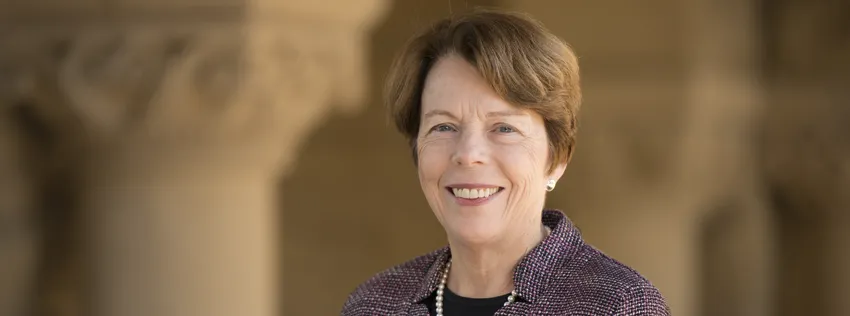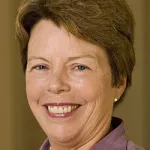
Inside Stanford Medicine, April 7th, 2014
Stanford recently announced two new institutes that bridge departmental and school boundaries — the Stanford Neurosciences Institute and the Stanford Institute for Chemical Biology — bringing the number of university-wide interdisciplinary laboratories, centers and institutes on campus to 18.
These institutes are in line with Stanford's longstanding tradition of the "independent labs" that bring researchers together to solve large problems, engaging faculty and their students in collaborations that range from international and economic studies to studies on the environment, energy and health. The growing trend toward interdisciplinary research recognizes the need to share expertise in tackling complex problems and is fueled in part by increased funding for projects that span disciplines. Writer Amy Adams recently sat down with Ann Arvin, MD, dean of research and vice provost, to talk about Stanford's focus on interdisciplinary research. Arvin is also the Lucile Salter Packard Professor of Pediatrics and a professor of microbiology and immunology.
Q: One of the buzzwords at Stanford is collaboration. Faculty easily cross lines and work outside boundaries. Why does that seem to flourish so easily here?
Arvin: We are fortunate that our tradition of fostering collaborative research was established years ago and became official back in 1982, when then-provost Albert Hastorf signed a very forward-thinking policy that called for interdisciplinary institutes to promote collaboration. The first independent labs were mostly in the hard sciences, but others that followed shortly thereafter were what is now the Freeman Spogli Institute for International Studies, the Stanford Institute for Economic Research and Policy and the Stanford Humanities Center. These programs paved the way for us to take advantage of new opportunities for interdisciplinary research and scholarship that are all around us now.
An important element of the Stanford organizational structure is that the dean of research is designated as the cognizant dean for the independent institutes. Again, the policy was very forward-looking because having a champion within any complex institution is needed. This structure is unusual among our research university peers.
Another very specific historic reason collaboration succeeds at Stanford is that we have seven schools, including our professional schools, on one campus. Even though Stanford can seem like a very big place, if you consider how many opportunities there are for faculty from various disciplines to encounter each other, you can appreciate why it's not so hard to overcome barriers to collaboration.
Q: Even with faculty on one campus, disciplines have distinct cultures that can present their own barriers. How do you facilitate crossing those lines?
Arvin: Much of what we do through the institutes and with school-based centers that cross disciplines is provide the venues and gathering places for faculty and students to get together, whether in a formal setting to hear talks by people who are coming at a problem from many different angles, such as the Uncommon Dialogues of the Stanford Woods Institute for the Environment, or in informal discussions where they learn approaches and ways of thinking that are relevant for their work. Of course, creating new collaborations is not an overnight thing. We also actively encourage interdisciplinary work by offering seed grants to teams of researchers, which have proved to be remarkably effective for bringing people together in productive collaborations.
In recent years Stanford has literally been building to enhance collaboration. Many of our newer buildings have a mix of different school-based programs and interdisciplinary labs and institutes. The Clark Center, which houses Bio-X, was really groundbreaking in that regard, placing faculty and students from different departments and schools side by side. It defined a new model for subsequent buildings bringing together researchers with diverse expertise. For example, Y2E2 [the Jerry Yang and Akiko Yamazaki Environment and Energy Building] is home to the Precourt Institute for Energy, the Woods Institute for the Environment and departments from the School of Earth Sciences and the School of Engineering. In addition to engineers and Earth scientists, those institutes also have faculty from the School of Law and the School of Humanities & Sciences. So the university has been creating a physical structure that mirrors research directions as we moved into a phase of expanding Stanford's interdisciplinary focus. We expect the new buildings being planned for the neurosciences and chemical biology institutes to continue this paradigm shift.
Q: Why the increased focus on interdisciplinary research? Have disciplines become too specialized?
Arvin: I don't think the disciplines have become too specialized at all. I am a firm believer that disciplines must be strong. But the intersections of disciplines are places where new ideas emerge and innovative research happens.
We are at a time in the history of science where the work that the disciplines have been doing is spilling out over the tops of whatever silos we have had. Researchers are finding that the analytical frameworks and the tools of one discipline are suddenly very relevant to other disciplines and revolutionizing the research that can be done.
That's why Bio-X [which bridges biology, the biomedical sciences, the physical sciences and engineering] was so groundbreaking when it was founded in 1998. Faculty who led this initiative had remarkable foresight about how these scientific disciplines would benefit from coming together in proximity in the Clark Center and through the networks created among faculty across the campus. The new Institute for Chemical Biology has also emerged from this tipping point. It connects people from chemistry, physics and biology in new research that will have major benefits for human health.
Our students are another important reason to encourage and facilitate interdisciplinary research. In fact, the momentum to take these approaches often comes from students who are highly motivated to seek out interdisciplinary opportunities. At the same time, we have to prepare our students to be able to function well in the new environment for research and scholarship where the ability to cross boundaries is increasingly important for success.
Q: The independent entities at Stanford often span many departments and schools. Are they ever at cross-purposes with the schools?
Arvin: Yes. It's not always tidy. As deans, we have to really work together to balance objectives in what sometimes involves a creative tension. For example, the departments and schools have the authority over faculty appointments, which the dean of research does not have, except for some faculty in the policy-related institutes, while the dean of research may be responsible for research space where the faculty member's program is located. But these challenges and the need to find common ground are just part of what it means to build and sustain these exciting new programs. A structure of schools and departments with independent labs, centers and institutes matrixed across this traditional organization may not be the easiest way to manage a university, but I think it has been quite well-accepted that the opportunities it creates are worth the effort.
Q: How much do you worry about the unpredictable nature of federal funding for scientific research?
Arvin: The fact that research funding is flat and has been so for several years now is very worrisome. Stanford faculty and students are fortunate to have some more diverse sources of support, including generous donors and industry partners, but I see no substitute for the national investment in university research. The most important priority of the Office of the Dean of Research is to help faculty be competitive for outside funding, which at the same time provides critical support for students and postdoctoral scholars. In this difficult environment, we have found that being able to put together an interdisciplinary team of investigators and providing pilot project support often enhances competitiveness for federal and foundation grants. That said, we know that research universities like Stanford are where fundamental discovery science gets done, and we need to communicate more effectively about this fact and the serious risks that are posed by reduced support.

